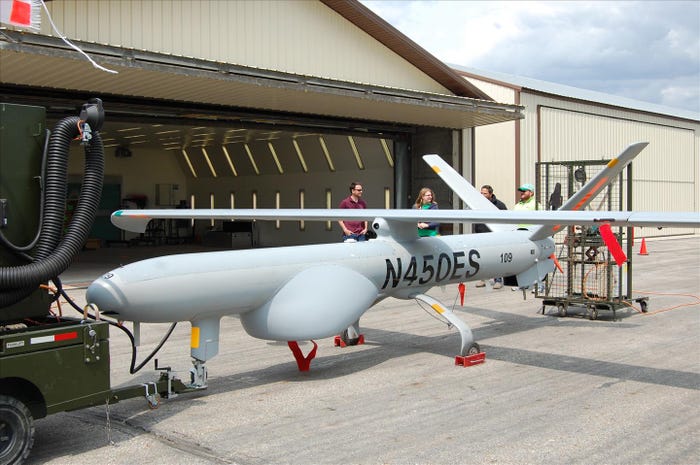Hermes 450 to fly over larger corridor in North Dakota to test ability for large UAS to capture imagery suitable for precision crop management.

A large unmanned aircraft to be used for agricultural research at North Dakota State University (NDSU) has taken its inaugural flight.
While small unmanned aircraft systems (UAS), most weighing 55 lb. or less, have proved to be useful in crop and livestock production, a group of North Dakota Agricultural Experiment Station scientists and NDSU Extension Service specialists think large UAS can play an important role in agriculture as well. As such, they are collaborating with the Hillsboro Airport Authority, some producers in Traill and Steele counties and Ft. Worth, Texas-based Elbit Systems of America on a research project to test that theory.

The Hermes 450 waits to be towed to the runway at the Hillsboro Municipal Airport. Source: NDSU photo
Elbit is a subsidiary of Elbit Systems Ltd., an Israel-based, high-tech company that provided the researchers with a Hermes 450, a UAS with a 35 ft. wingspan similar to a single-engine manned aircraft. The UAS was flown, in sections, to the U.S. from Israel and then was trucked to North Dakota, where it recently was assembled.
“Small UAS are ideal for scouting crops and livestock and can be used effectively to capture imagery for precision management decisions — such as variable-rate, in-season fertilization, weed identification, livestock inventory and identifying sick animals — but small UAS are relatively limited by flight time and cannot easily capture imagery of thousands of acres on the same day,” said NDSU extension agricultural machine systems specialist John Nowatzki, the principal investigator on this project.
He added that large UAS will be needed to collect high-spatial and temporal-resolution imagery over entire regions in a timely manner.
One of the benefits of using UAS for agricultural purposes is saving time, but if a producer has to drive a small UAS from field to field, then it really isn’t much of a time saver, noted Sreekala Bajwa, chair of NDSU’s agricultural and biosystems engineering department and a co-investigator on this project.
“Most small UAS need to capture hundreds of individual images to make a single mosaicked image of one square mile,” Nowatzki said. “A large UAS could capture high-resolution imagery of one square mile in a single image. This would make it possible to capture imagery useable for precision crop management over hundreds of thousands of acres in a single day at very high resolution.”
The NDSU project will use the Hermes 450 and small rotocopter and fixed-wing UAS to collect imagery from a 4 x 40-mile corridor in east-central North Dakota every two weeks during the 2016 crop-growing season. The Hermes 450 will gather images from altitudes of 3,000, 5,000 and 8,000 ft., while the small UAS will fly at 400 ft. or lower.
The UAS will collect data on stand counts in corn, sunflowers and sugar beets, the effectiveness of nitrogen applied to corn and wheat, iron chlorosis deficiency in soybeans and yield predictions for corn, soybeans, wheat, sugar beets and sunflowers. The researchers plan to test whether UAS also can benefit livestock producers, such as by inventorying cattle in pastures.
The intent is to compare the data collected from the air at various altitudes with data collected through satellite imagery, in-field observations, on-the-ground sensors, detailed soil analyses and harvest yield information.
“This research is the first of its kind in the nation,” Bajwa said.
Researchers also plan to assess the costs associated with collecting UAS imagery, including personnel, transportation, the number of flights required to gather sufficient data, the time required to collect the information, the area of coverage per flight and maintenance costs per hour of flight to determine whether using UAS for agricultural purposes is economical.
Trajectory information from the UAS flights will be shared with the Federal Aviation Administration (FAA), which is developing regulatory standards for the use of UAS. FAA recently approved the Hermes 450 flight as part of the Northern Plains UAS Test Site in North Dakota. The state was selected in 2013 as one of six FAA test sites and is conducting research that will assist FAA in developing those standards.
Because FAA requires UAS to be flown within the operator’s line of sight and the Hermes 450 will go beyond that, the North Dakota wing of the Civil Air Patrol will fly a chase plane with a visual observer who will be in constant radio communication with the ground-based UAS operators, Nowatzki said.
About the Author(s)
You May Also Like



